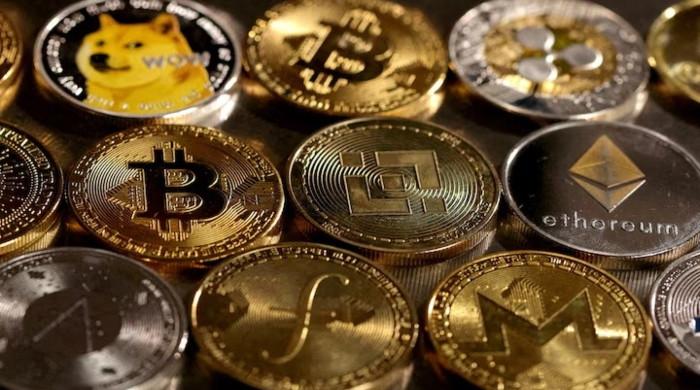- Gold climbs 19.2% after Rs52,600 gain in 2024.
- PSX’s KSE-100 up 84% in 2024, continues rally.
- Crypto remains high-risk, suited for younger investors.
KARACHI: Pakistan’s financial markets have seen a sustained bullish trend in recent months.
The benchmark KSE-100 Index of the Pakistan Stock Exchange (PSX) surged by 84% in 2024, ending the year at 115,127 points, and has since climbed another 2.3% to reach 117,806.75, according to The News.
Gold also delivered strong returns, closing 2024 at Rs272,600 — a gain of Rs52,600 — and has since soared by 19.2% to Rs325,000.
Amid this performance by traditional assets, Pakistan is also venturing into emerging sectors. The establishment of the Pakistan Crypto Council reflects the country’s intent to adopt cryptocurrencies, a move welcomed by several financial experts.
As the financial markets see a shakeup, investors may find themselves questioning how to diversify their investment portfolio to make the most of the bullish markets. Most importantly, what should they choose: gold, stocks or cryptocurrencies?
In his conversation with The News, Mustafa Fahim, an investment banker working in the Middle East, says that while “it is a great thing that Pakistan is embracing the crypto movement and the crypto asset class, all three assets should be part of an investor’s portfolio.”
He says asset allocation depends on time horizon, age and risk appetite. “If someone is young, they can have a larger proportion of their investment in crypto (say around 10%), which is high given crypto is a highly volatile asset, and the investor who is looking for decent and relatively stable returns should not have a lot of it in their portfolio.”
But Fahim advises investors to have a larger share of their investment in stocks, especially index funds, in the Pakistani stock market.
Acknowledging the inherently volatile nature of stocks, the investment banker adds that “the volatility is not high, especially when someone is investing in index funds because they invest in stable equities like large companies of Pakistan. Over the years, the stock market has given an annualised average return of around 20%, which is good.”
Fahim advises keeping a large chunk of investments — around 60-70% — in stocks, which, he says, will increase the most in the future.
Shankar Talreja, director of research at Topline Securities, believes Pakistan equities have “much better room to perform in the next 12 months.” He says that the IMF review will further enhance the overall confidence of investors.
“Currently our market is valued at 5.5x of the earnings multiple, and historically, the market has traded at 7x of the earnings. This provides upside of 27%, and with the dividend yield of 10%, the total return can be around 35-40%.” Talreja explains.
On gold, Talreja says that the price of over $3000% ounce warrants some caution, and in Pakistan, gold return constitutes both appreciation in international gold prices and movement of our currency.
“So, in my view, the return on gold in the next 12 months would be much lower than the last 12 months. Generally, gold is considered a safe haven in times of uncertainty,” he said.
Muhammad Usman Siddiqui, a research analyst covering MENA equities, also sees gold as a stable option in times of uncertainty, calling gold the preferred asset class for investors. He says that given the current global economics and the uncertain political situation, like the Russia-Ukraine war, most investors are leaning towards gold.
Over the last 30 days or so, “we have seen investors pulling out money from equities and investing in safer assets [like gold]” since it tends to perform well during higher inflation and recession.
He notes that while gold is safer, equities are the better choice in Pakistan. According to Siddiqui, stocks are a lot more affordable as investors can buy shares in blue-chip companies at relatively cheap rates. “In my opinion, the asset allocation could be: 50% gold, 40% equities, and a small chunk in crypto — only for exposure.”
He adds that since crypto is not yet a developed asset in Pakistan in terms of regulation, “Being a conservative investor, I would not recommend investing in this asset class, especially to those who may use their retirement savings or pension funds for investments.”
Young investors with higher risk tolerance can allocate a small portion to crypto. “But still, I would go with the old school investment philosophy, which is equities, stock market and gold.”
For the stock market too, he advises investors to choose blue-chip companies since they have less volatility in their earnings and revenue and are more likely to withstand any economic and political headwinds.
On affordability, a Karachi-based small investor, requesting anonymity, echoes Siddiqui’s argument. He says that for investment in gold, investors would need “millions of rupees. Whereas, in stocks, the trading journey could be started from a lesser amount.” He adds that one can enter the crypto and stock markets with only Rs100,000.
According to him, there is still uncertainty around crypto, “if the government is serious about legalising the currency, it would be a great addition. Investors should have the ease of roping in their bank accounts for crypto trade.”
For Fahim, gold is a safe and stable asset, but it should not dominate an investment portfolio as its returns are relatively modest. He says that “while over the past two years, gold has had decent increases — around 40%, if we look at its annualised return in the past 20-30 years, its return has not been as high as investors could get in stocks — or even crypto”.
Fahim’s asset allocation goes: the priority should be stocks for long-term growth, followed by gold as a stabilising asset, and then crypto as a high-risk, high-reward option. Within crypto, “Bitcoin is a better option because it is the original digital currency.” He thinks that “Bitcoin is here to stay.”
“Gold should be in the portfolio but as a stabilising asset class — in case of any liquidity issues, gold can be easily liquidated,” he explains.
Talreja too advises caution regarding cryptocurrencies. “Although [crypto’s] adaption ratio is increasing, it is a highly volatile and high-risk investment class with no clarity over its return expectation for the next 12 months, at least to me.”
Although financial experts and investors do not lean towards crypto, unofficial figures say that there are around 20 million crypto users within the country registered on different exchanges. Blockchain analytics firm Chainalysis ranked Pakistan ninth on its Global Crypto Adoption Index 2024.
In contrast, stock market participation remains low, with 324,952 individual and 9,685 corporate accounts, according to the Central Deposit Company (CDC). Why are stocks unpopular among individual investors or does a low number reflect people’s aversion to regulations?
On this, Talreja says that he does not “buy this argument of 20 million users. Nowadays, many investment options with link towards cryptos are being promoted, and no one knows whether it is actually crypto investment or something else.”
Per Talreja, these investment schemes offer significant referral bonuses which encourage existing users to find new ones and the chain goes on. “Nevertheless, users of these schemes/cryptos are for sure higher than stock market investors. It is an easy investing experience in cryptos than stocks, with account being opened in minutes — and also no tax on profit.”
Fahim lends support to the argument, “First, let’s dig deeper into this 20 million figure. That there are 20 million crypto users in Pakistan might be correct, but that does not mean that there are 20 million crypto investors in Pakistan.
The equivalent data for stocks shows that there are stock investors and then there are people who use the businesses that those stock represents.”
He says that it is not correct to compare the 20 million figure with investors in the stock market. “People use crypto for mostly transaction purposes in Pakistan, and that too, mostly for black market transactions or if they do not want to be in the banking system or pay taxes. This where crypto is being used a lot, and because of that it is being bought and sold.”
But are people buying crypto as an investment, Fahim explains, “That’s a totally different ball game.” On people’s resistance to embracing stocks, he said: “One of the reasons that people have not gone towards stocks is because of a lack of knowledge. Financial literacy remains low in Pakistan. Then, there is a general understanding that gold is the best investment or real estate, and people do not go for anything else apart from these two assets.”
“Hence, there are these preconceived biases in people which education can change.” According to Fahim, taxes also play a big role in discouraging new entrants, “there are capital gains taxes and dividend taxes. This does reduce people’s incentive to invest in the market.”
When The News asked if the resistance to stock markets is influenced by representation of stocks in pop culture (movies more focused on market crashes, Fahim added: “Those documentaries are seen by people across the world. But then again, that has not affected people in the US or India; they still invest in the market.
“I think the reason is that there has not been enough education in the market. And I think a lot of companies are changing this perception in Pakistan. Apps and startups are promoting long-term stock investments.”
“Crypto will have investors as well because of its use, and if it gets legalised, this 20 million figure would grow. But it might have a converse effect, because it would also come under the tax net. And with that, investment sentiment could shift.”
While the verdict remains mostly in favour of stocks, Fahim adds an afterthought: “[Investment] depends on a person’s stage of life, risk appetite, etc. If someone is close to retirement, they should have money in risk-free assets like gold.
“Younger people should have a lot more in stocks because by the time they retire or by the time they want to make a large purchase like a house, they want to maximise their investment and that can be done through stocks.”


